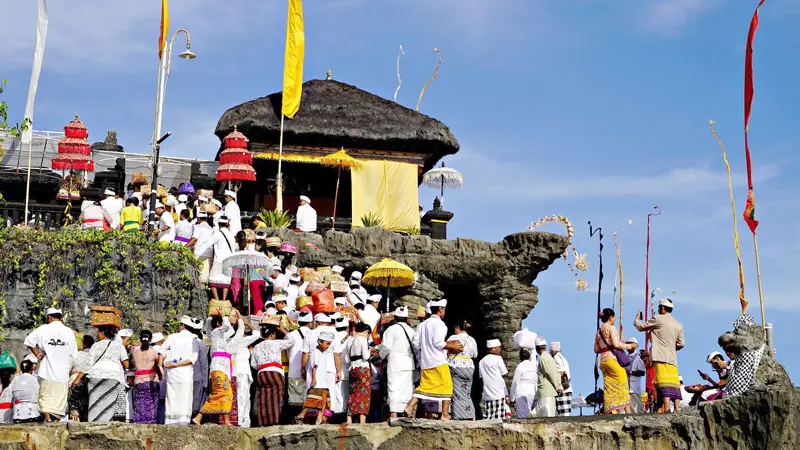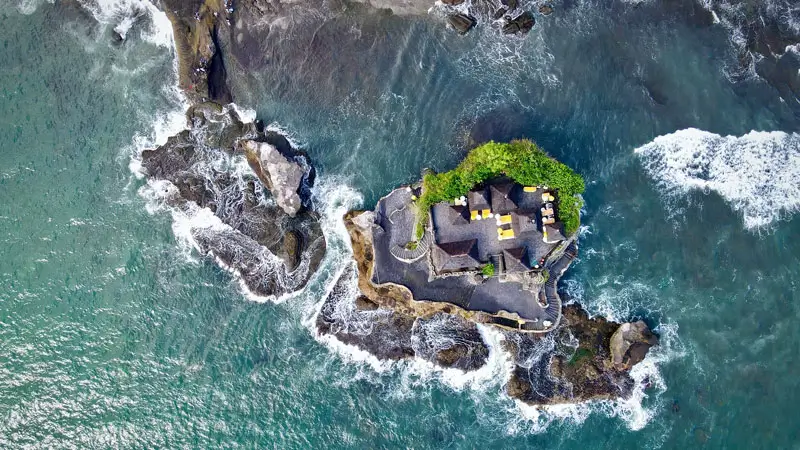Have you ever wondered about the history and spiritual significance of Tanah Lot Temple Bali? Perched on a rocky islet, surrounded by the waves of the Indian Ocean, this sacred sea temple has been a place of worship and devotion for Balinese Hindus for centuries.

In this guide, you will learn about Tanah Lot Temple’s history, the legends about its creation, and its cultural importance in Bali. If you are planning a visit or want to know more about its fascinating story, keep reading.
Table of Contents[Hide][Show]
History of Tanah Lot Temple and Its Origins
Dang Hyang Nirartha’s Spiritual Journey
The story of Tanah Lot Temple begins in the 16th century with the arrival of Dang Hyang Nirartha, a revered Hindu priest from Java. He traveled to Bali during the reign of King Dalem Waturenggong, a ruler known for supporting the spread of Hinduism across the island.
“As Nirartha journeyed along Bali’s coastline, he established several sacred temples, including Tanah Lot, as places of worship and spiritual learning. Among Balinese Hindus, he is also known as Pedanda Sakti Wawu Rawuh, a title signifying his spiritual power. Dang Hyang Nirartha played a key role in spreading Hinduism in Bali, establishing many coastal temples, including Tanah Lot and Uluwatu Temple.” (Source: wikipedia.org)
Beraban Village, Tabanan: The Origins of Tanah Lot Temple

One evening, while traveling along Bali’s southern coast, Dang Hyang Nirartha saw a mystical light glowing from the sea. Drawn to its energy, he followed the light until he arrived at Beraban Village, Tabanan, where he discovered a parrot-shaped rock formation by the shore. Believing it to be a place of strong spiritual significance, he chose to meditate there.
“Occasionally, Dang Hyang Nirartha also visited Pekendungan Temple to give dharma wacana (religious sermons) to the local community.” (Source: baliexpress.jawapos.com)
At that time, Bendesa Beraban Sakti, the village leader, opposed Nirartha’s teachings and was unhappy that many villagers had started embracing Hinduism. He and his followers attempted to expel Nirartha from the area. But what happened next became the foundation of Tanah Lot’s legend.
Legend of the Sacred Snake Guardian
As Bendesa Beraban and his men approached to drive Nirartha away, the priest waved his sacred shawl, and suddenly, a black and white snake appeared from the rocks. The snake slithered toward the villagers, startling them and making them believe in Nirartha’s supernatural powers.
Since then, the Balinese people have regarded this snake as the guardian of the Tanah Lot Temple, symbolizing spiritual protection and balance. Visitors can still find these sacred snakes hiding within the coral rock crevices near the temple.
This snake species, scientifically named Bungarus candidus or Malayan krait, is known for its distinctive black-and-white pattern. While revered as a guardian, it is also highly venomous, so visitors are advised not to disturb it.
The Legend of the Moving Rock

The legend doesn’t end with the sacred snake. When the villagers continued to resist, Dang Hyang Nirartha showed his spiritual strength once again. He used his mystical abilities to lift the rock, where he meditated and moved it into the sea, creating a barrier between it and the mainland.
From that moment, the site became known as Tanah Lot, which means “Land in the Sea”—a fitting name for the temple that now sits on a rocky islet, surrounded by the ocean at high tide.
When Bendesa Beraban and his followers saw this miracle, they stopped resisting and accepted Hindu teachings. This moment was key to the growth of Hinduism in the area and strengthened the spiritual importance of Tanah Lot.
The Sacred Keris and Spiritual Heritage
Before leaving Beraban Village, Dang Hyang Nirartha gifted a sacred keris (dagger) to Bendesa Beraban, symbolizing protection and blessing for the local community.
This spiritual heirloom was later enshrined at Puri Kediri, where it became part of religious ceremonies held at Tanah Lot Temple every six months.
The Importance of Tanah Lot Temple for the Balinese People
For centuries, Tanah Lot Temple has been more than just a sacred site for Balinese Hindus—it is also believed to serve as a spiritual protector of Bali. Many locals consider it a guardian temple that shields the island from negative energies and maintains a balance between land and sea.
Tanah Lot is more than just a beautiful temple; it’s a cultural gem! With its amazing seaside views and enchanting vibe, it attracts visitors from all around the world. It’s one of Bali’s most loved spiritual spots, and you can really feel the magic when you’re there!
Religious Rituals and Ceremonies at Tanah Lot Temple
Piodalan: The Temple’s Anniversary Celebration

One of the most important religious events at Tanah Lot is Piodalan, a sacred temple anniversary ceremony that takes place every 210 days based on the Balinese Pawukon calendar (Budha Wage Langkir).
In 2025, Piodalan at Tanah Lot Temple falls on May 7. On this special day, many Balinese Hindus come together at the temple to pray, make offerings, and join in religious processions that honor the temple’s spiritual energy.
Other Sacred Rituals at Tanah Lot Temple
Besides Piodalan, Tanah Lot Temple hosts several important Hindu ceremonies throughout the year.
- Daily Prayers – Performed by locals to seek protection, prosperity, and blessings.
- Melasti Ceremony – A purification ritual before Nyepi (Balinese New Year), where Hindus carry sacred statues (pratima) to the sea for spiritual cleansing.
- Fishermen’s Blessing Ceremony – A special ritual where local fishermen pray for safety before heading to sea.
- Meditation & Prayer – Many Hindus visit the temple for spiritual reflection and peace.
The Hindu priests of Tanah Lot have kept these traditions alive for many years. They make sure that the temple continues to be an important part of Balinese Hindu culture.
The Uniqueness of Tanah Lot Temple and Efforts to Preserve It
Tanah Lot Temple is not only spiritually significant but also stands out due to its extraordinary location—perched atop a massive rock formation in the sea.
Its magnificent shape with a tiered meru roof symbolizes the abode of the gods in Balinese Hindu beliefs.
History of Tanah Lot Temple Conservation Efforts

However, due to being continuously hit by waves, this temple has experienced natural abrasion.
Since 1987, the Balinese government has worked to protect the environment. They have focused on improving the coral rock structure and have moved the breakwater below the water’s surface.
Key restoration milestones include:
- 1987 → Initial protection with installation of breakwaters.
- 1992 → Structural modifications to maintain the temple’s natural beauty.
- 2000-2003 → Tourist area improvements, including renovation of Wantilan and Candi Bentar.
- 2024 → Further restoration with an IDR 11 billion budget to strengthen temple security.
For more details on Tanah Lot Temple’s conservation history, visit Wikipedia – Tanah Lot.
The Attraction of Tanah Lot Temple: A Blend of History and Natural Beauty

In addition to its history, spiritual value, and unique architecture, Tanah Lot Temple is also famous as one of the best spots to enjoy the sunset in Bali.
For a more comfortable experience, we recommend travelers come in the afternoon and earlier to get the best view without getting caught in the crowd.
Religious Tourism Around Tanah Lot Temple
In addition to Tanah Lot Temple, there are several religious destinations around it, such as Batu Bolong Temple, which is located on a cliff with a view of the sea.
To get the best holiday experience at Tanah Lot Temple, check out the following guide:
- Holiday Tips for Tanah Lot Temple → Essential tips for a comfortable and memorable visit.
- Tanah Lot Entrance Ticket Prices → Stay updated on current ticket prices for better trip planning.
- Tanah Lot Holiday Itinerary → Discover the best itinerary for exploring Tanah Lot in a day.
- Latest Tanah Lot Kecak Dance Ticket Prices → Witness the unique Kecak Dance performance with updated ticket info.
Bahasa Indonesia:

 Three Days Vacation Itinerary in Nusa Dua – Ultimate Travel Guide & Tips
Three Days Vacation Itinerary in Nusa Dua – Ultimate Travel Guide & Tips
We'd love to hear from you! Share your thoughts or experiences in the comments below!